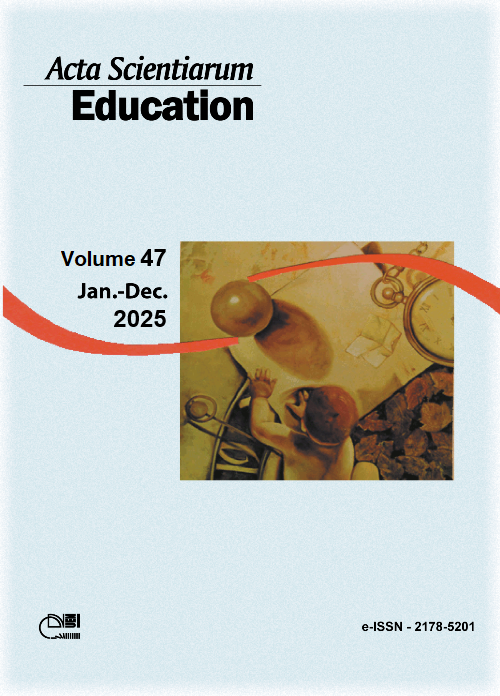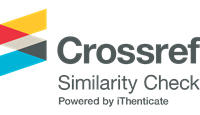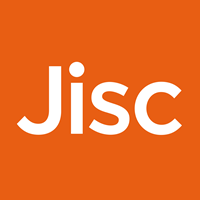Eficácia dos programas de informação e comunicação para crianças com necessidades educacionais especiais no contexto do desenvolvimento da fala
Resumo
O objetivo do trabalho é determinar a eficácia dos programas de informação e comunicação para necessidades educativas especiais (NEEs) no contexto do desenvolvimento da fala. O objetivo foi alcançado através da utilização de métodos teóricos gerais de análise, observações e cálculos do fator de classificação, coeficiente de eficiência, coeficiente de correlação de Phillips. Estabeleceu-se que as abordagens mais eficazes para o desenvolvimento da fala infantil são o uso de tecnologias de informação (2,5), interação social (2,37), abordagem em grupo (2,25). Os resultados obtidos fundamentaram o desenvolvimento de um programa de fala e desenvolvimento geral de crianças de 4 a 7 anos. O programa previa a criação de mapas mentais, oferta de leitura conjunta, execução de músicas educativas, desenvolvimento da fala de acordo com o tema especificado. A formação tornou-se possível devido à utilização de tecnologias modernas, nomeadamente as aplicações MindMeister, Inclusão Digital, síntese de voz do Google e YouTube. Verificou-se que o programa desenvolvido teve um efeito positivo na melhoria da fala fonética das crianças em comparação com os resultados no início do estudo. O significado prático do trabalho implica a possibilidade de utilização do programa desenvolvido para correção de fala entre um maior número de crianças. As perspectivas de pesquisa estão relacionadas à elaboração de mecanismos de desenvolvimento da fala em função do grau de comprometimento da fala.
Downloads
Referências
Alzrayer, N. M., Banda, D. R., & Koul, R. K. (2019). The effects of systematic instruction in teaching multistep social-communication skills to children with autism spectrum disorder using an iPad. Developmental Neurorehabilitation, 22(6), 415-429. https://doi.org/10.1080/17518423.2019.1604578
Ansari, R., Loraine, E., & Gréaux, M. (2022). Impact of COVID-19 on digital practice in UK paediatric speech and language therapy and implications for the future: a national survey. International Journal of Language and Communication Disorders, 57(5), 1112-1129. https://doi.org/10.1111/1460-6984.12750
Bayard, C., Machart, L., Strauß, A., Gerber, S., Aubanel, V., & Schwartz, J.-L. (2019). Cued speech enhances speech-in-noise perception. Journal of Deaf Studies and Deaf Education, 24(3), 223-233. https://doi.org/10.1093/deafed/enz003
Bogaert, L. Van, Machart, L., Gerber, S., Lœvenbruck, H., & Vilain, A. (2023). Speech rehabilitation in children with cochlear implants using a multisensory (French Cued Speech) or a hearing-focused (Auditory Verbal Therapy) approach. Frontiers in Human Neuroscience, 17, 1152516. https://doi.org/10.3389/fnhum.2023.1152516
Brock, K. L., Zolkoske, J., Cummings, A., & Ogiela, D. A. (2022). The effects of symbol format and psycholinguistic features on receptive syntax outcomes of children without disability. Journal of Speech, Language, and Hearing Research, 65(12), 4741-4760. https://doi.org/10.1044/2022_JSLHR-22-00022
Bruinsma, G., Wijnen, F., & Gerrits, E. (2020). Focused stimulation intervention in 4-and 5-year-old children with developmental language disorder: Exploring implementation in clinical practice. Language, Speech, and Hearing Services in Schools, 51(2), 247-269. https://doi.org/10.1044/2020_LSHSS-19-00069
Bruinsma, G., Wijnen, F., & Gerrits, E. (2023). Language gains in 4–6-year-old children with developmental language disorder and the relation with language profile, severity, multilingualism and non-verbal cognition. International Journal of Language and Communication Disorders, 58(3), 765-785. https://doi.org/10.1111/1460-6984.12821
Cappadona, I., Ielo, A., La Fauci, M., Tresoldi, M., Settimo, C., Cola, M. C., Muratore, R., Domenico, C., Cara, M., Corallo, F., Tripodi, E., Impallomeni, C., Quartarone, A., & Cucinotta, F. (2023). Feasibility and effectiveness of speech intervention implemented with a virtual reality system in children with developmental language disorders: A pilot randomized control trial. Children, 10(8), 1336. https://doi.org/10.3390/children10081336
Cardile, D., Ielo, A., Corallo, F., Cappadona, I., D’Aleo, G., Cola, M. C., Bramanti, P., & Ciurleo, R. (2023). Communication training: Significance and effects of a preliminary psychological intervention upon an audit team. International Journal of Environmental Research and Public Health, 20(5), 4173. https://doi.org/10.3390/ijerph20054173
Church, J. A., Grigorenko, E. L., & Fletcher, J. M. (2023). The role of neural and genetic processes in learning to read and specific reading disabilities: implications for instruction. Reading Research Quarterly, 58(2), 203-219. https://doi.org/10.1002/rrq.439
Fink, M., Weissgarber, L., & Wren, P. (2022). Speech disorders. In R. J. Rinaldi, & R. Srinivasan (eds.), Handbook of pediatric rehabilitation medicine (pp. 253-262). Springer Publishing. https://doi.org/10.1891/9780826184498
Hurwitz, L. B. (2023). SpEdTech: Design and effects of assistive and instructional technologies for children with disabilities. Encyclopedia of Child and Adolescent Health, 3, 450-460. https://doi.org/10.1016/B978-0-12-818872-9.00163-1
Key, A. P., Roth, S., & Venker, C. (2022). Spoken language comprehension in children and adults with Angelman Syndrome. Journal of Communication Disorders, 100, 106272. https://doi.org/10.1016/j.jcomdis.2022.106272
Knabe, M. L., Schonberg, C. C., & Vlach, H. A. (2023). Does the public know what researchers know? Perceived task difficulty impacts adults’ intuitions about children’s early word learning. Cognitive Research: Principles and Implications, 8(45). https://doi.org/10.1186/s41235-023-00493-y
Morgan, A. T., Murray, E., & Liégeois, F. J. (2018). Interventions for childhood apraxia of speech. Cochrane Database of Systematic Reviews, 2018(5), CD006278. https://doi.org/10.1002/14651858.CD006278.pub3
Muharib, R., Alzrayer, N. M., Wood, C. L., & Voggt, A. P. (2019). Backward chaining and speech-output technologies to enhance functional communication skills of children with autism spectrum disorder and developmental disabilities. AAC: Augmentative and Alternative Communication, 35(4), 251-262. https://doi.org/10.1080/07434618.2019.1704433
National Committee for Research Ethics in Science and Technology. (2016). Guidelines for Research Ethics in Science and Technology. https://stip.oecd.org/stip/interactive-dashboards/policy-initiatives/2023%2Fdata%2FpolicyInitiatives%2F99994767
Peng, A., Orosco, M. J., Wang, H., Swanson, H. L., & Reed, D. K. (2022). Cognition and writing development in early adolescent English learners. Journal of Educational Psychology, 114(5), 1136-1155. https://doi.org/10.1037/edu0000695
Pennington, L., Akor, W. A., Laws, K., & Goldbart, J. (2018). Parent-mediated communication interventions for improving the communication skills of preschool children with non-progressive motor disorders. Cochrane Database of Systematic Reviews, 2018(7), CD012507. https://doi.org/10.1002/14651858.CD012507.pub2
Popovych, I., Kokorina, Y., Pyslar, A., Palchynska, M., Pavliuk, M., Raіevska, Y., & Torop, K. (2022). Research of the mental states of anxiety of fourthgraders in secondary schools during the progression of the COVID-19 pandemic. Revista Românească pentru Educaţie Multidimensională, 14(1), 32-51. https://doi.org/10.18662/rrem/14.1/506
Rinaldi, P., Bello, A., Simonelli, I., & Caselli, M. C. (2023). Is specific learning disorder predicted by developmental language disorder? Evidence from a follow-up study on Italian children. Brain Sciences, 13(4), 701. https://doi.org/10.3390/brainsci13040701
Rong, Y., Weng, Y., & Peng, G. (2023a). Processing of acoustic and phonological information of lexical tones at pre-attentive and attentive stages. Language, Cognition and Neuroscience, 39(2). https://doi.org/10.1080/23273798.2023.2260022
Rong, Y., Weng, Y., Chen, F., & Peng, G. (2023b). Categorical perception of Mandarin lexical tones in language-delayed autistic children. Autism, 27(5), 1426-1437. https://doi.org/10.1177/13623613221138687
Schmitt, K. L., Hurwitz, L. B., & Nichols, D. (2022). Learning to eRead: A qualitative exploration of young children's developing eReader practices. Journal of Computer Assisted Learning, 38(2), 488-499. https://doi.org/10.1111/jcal.12631
Seyhan-Biyik, K., Esen-AydinlI, F., Sel, S. A., Incebay, Ö., Özcebe, E., Kerem-Günel, M., Anlar, F. B., & Pennington, L. (2023). Psychometric properties of the Viking Speech Scale-Turkish version for children with cerebral palsy aged 4-18 years based on live and video-based observation. International Journal of Language and Communication Disorders, 58(3), 687-703. https://doi.org/10.1111/1460-6984.12810
Ternavska, Т., Raievska, Y., Mishenina, T., & Poberezhna, N. (2020). Pedagogical and socio-psyhological conditionsof effective carrier guidance of future social specialists. European Humanities Studies: State and Society, 3(І), 153-172. https://doi.org/10.38014/ehs-ss.2020.3-1.11
Tsaras, K., Papathanasiou, I. V., Vus, V., Panagiotopoulou, A., Katsou, M. A., Kelesi, M., & Fradelos, E. C. (2018). Predicting factors of depression and anxiety in mental health nurses: A quantitative cross-sectional study. Medical Archives (Journal of the Academy of Medical Sciences in Bosnia and Herzegovina), 72(1), 62-67. https://doi.org/10.5455/medarh.2017.72.62-67
Ulriksen, L. B., Bilet-Mossige, M., Moreira, H. C., Larsen, K., & Nordahl-Hansen, A. (2023). Reading intervention for students with intellectual disabilities without functional speech who require augmentative and alternative communication: A multiple single-case design with four randomized baselines. Trials, 24(433). https://doi.org/10.1186/s13063-023-07452-4
Wang, H., Orosco, M. J., Peng, A., Long, H., Reed, D. K., & Lee Swanson, H. (2024). The relation of bilingual cognitive skills to the second language writing performance of primary grade students. Journal of Experimental Child Psychology, 238, 105776. https://doi.org/10.1016/j.jecp.2023.105776
Xue, J., Zhuo, J., Li, P., & Li, H. (2023). Locus of nonword repetition impairments in Mandarin-speaking children with developmental language disorder. Research in Developmental Disabilities, 142, 104605. https://doi.org/10.1016/j.ridd.2023.104605
Xue, J., Zhuo, J., Li, P., Liu, J., & Zhao, J. (2022). Characterizing macro- and micro-structures of narrative skills for Mandarin-speaking school-age children with specific language impairment. Journal of Communication Disorders, 96, 106199. https://doi.org/10.1016/j.jcomdis.2022.106199
This work is licensed under a Creative Commons Attribution 4.0 International License.
DECLARAÇÃO DE ORIGINALIDADE E DIREITOS AUTORAIS
Declaro que o presente artigo é original, não tendo sido submetido à publicação em qualquer outro periódico nacional ou internacional, quer seja em parte ou em sua totalidade.
Os direitos autorais pertencem exclusivamente aos autores. Os direitos de licenciamento utilizados pelo periódico é a licença Creative Commons Attribution 4.0 (CC BY 4.0): são permitidos o compartilhamento (cópia e distribuição do material em qualquer suporte ou formato) e adaptação (remix, transformação e criação de material a partir do conteúdo assim licenciado para quaisquer fins, inclusive comerciais).
Recomenda-se a leitura desse link para maiores informações sobre o tema: fornecimento de créditos e referências de forma correta, entre outros detalhes cruciais para uso adequado do material licenciado.














































